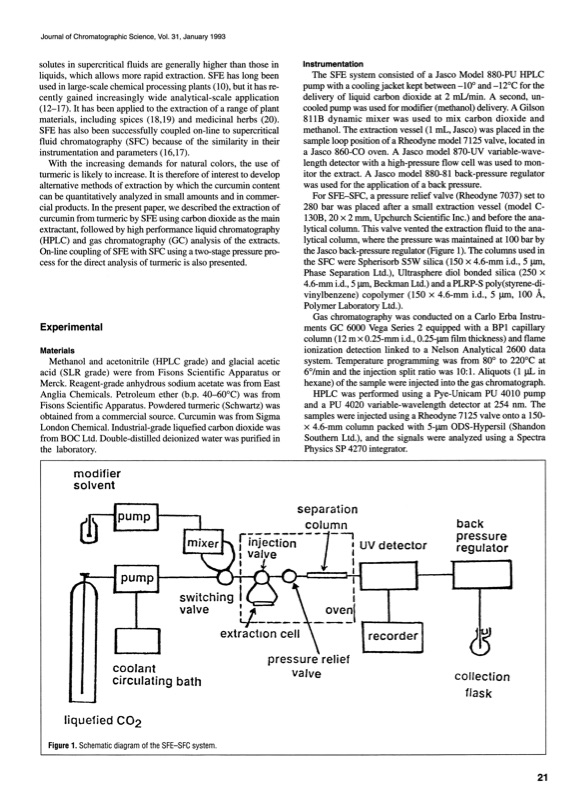
PDF Publication Title:
Text from PDF Page: 002
Journal of Chromatographic Science, Vol. 3 1 , January 1993 solutes in supercritical fluids are generally higher than those in liquids, which allows more rapid extraction. SFE has long been used in large-scale chemical processing plants (10), but it has re cently gained increasingly wide analytical-scale application (12-17). It has been applied to the extraction of a range of plant materials, including spices (18,19) and medicinal herbs (20). SFE has also been successfully coupled on-line to supercritical fluid chromatography (SFC) because of the similarity in their instrumentation and parameters (16,17). With the increasing demands for natural colors, the use of turmeric is likely to increase. It is therefore of interest to develop alternative methods of extraction by which the curcumin content can be quantitatively analyzed in small amounts and in commer cial products. In the present paper, we described the extraction of curcumin from turmeric by SFE using carbon dioxide as the main extractant, followed by high performance liquid chromatography (HPLC) and gas chromatography (GC) analysis of the extracts. On-line coupling of SFE with SFC using a two-stage pressure pro cess for the direct analysis of turmeric is also presented. Experimental Materials Methanol and acetonitrile (HPLC grade) and glacial acetic acid (SLR grade) were from Fisons Scientific Apparatus or Merck. Reagent-grade anhydrous sodium acetate was from East Anglia Chemicals. Petroleum ether (b.p. 40-60°C) was from Fisons Scientific Apparatus. Powdered turmeric (Schwartz) was obtained from a commercial source. Curcumin was from Sigma London Chemical. Industrial-grade liquefied carbon dioxide was from BOC Ltd. Double-distilled deionized water was purified in the laboratory. Instrumentation The SFE system consisted of a Jasco Model 880-PU HPLC pump with a cooling jacket kept between -10° and -12°C for the delivery of liquid carbon dioxide at 2 mL/min. A second, un- cooled pump was used for modifier (methanol) delivery. A Gilson 811B dynamic mixer was used to mix carbon dioxide and methanol. The extraction vessel (1 mL, Jasco) was placed in the sample loop position of a Rheodyne model 7125 valve, located in a Jasco 860-CO oven. A Jasco model 870-UV variable-wave length detector with a high-pressure flow cell was used to mon itor the extract. A Jasco model 880-81 back-pressure regulator was used for the application of a back pressure. For SFE-SFC, a pressure relief valve (Rheodyne 7037) set to 280 bar was placed after a small extraction vessel (model C- 130B, 20 × 2 mm, Upchurch Scientific Inc.) and before the ana lytical column. This valve vented the extraction fluid to the ana lytical column, where the pressure was maintained at 100 bar by the Jasco back-pressure regulator (Figure 1). The columns used in the SFC were Spherisorb S5W silica (150 × 4.6-mm i.d., 5 μm, Phase Separation Ltd.), Ultrasphere diol bonded silica (250 × 4.6-mm i.d., 5 μm, Beckman Ltd.) and a PLRP-S poly(styrene-di- vinylbenzene) copolymer (150 x 4.6-mm i.d., 5 μm, 100 Å, Polymer Laboratory Ltd.). Gas chromatography was conducted on a Carlo Erba Instru- ments GC 6000 Vega Series 2 equipped with a BP1 capillary column (12 m × 0.25-mm i.d., 0.25-μm film thickness) and flame ionization detection linked to a Nelson Analytical 2600 data system. Temperature programming was from 80° to 220°C at 6°/min and the injection split ratio was 10:1. Aliquots (1 μL in hexane) of the sample were injected into the gas chromatograph. HPLC was performed using a Pye-Unicam PU 4010 pump and a PU 4020 variable-wavelength detector at 254 nm. The samples were injected using a Rheodyne 7125 valve onto a 150- × 4.6-mm column packed with 5-μm ODS-Hypersil (Shandon Southern Ltd.), and the signals were analyzed using a Spectra Physics SP 4270 integrator. Figure 1. Schematic diagram of the SFE-SFC system. 21PDF Image | Supercritical Fluid Extraction Turmeric

PDF Search Title:
Supercritical Fluid Extraction TurmericOriginal File Name Searched:
turmeric-supercritical-co2-extraction.pdfDIY PDF Search: Google It | Yahoo | Bing
CO2 Organic Rankine Cycle Experimenter Platform The supercritical CO2 phase change system is both a heat pump and organic rankine cycle which can be used for those purposes and as a supercritical extractor for advanced subcritical and supercritical extraction technology. Uses include producing nanoparticles, precious metal CO2 extraction, lithium battery recycling, and other applications... More Info
Heat Pumps CO2 ORC Heat Pump System Platform More Info
| CONTACT TEL: 608-238-6001 Email: greg@infinityturbine.com | RSS | AMP |